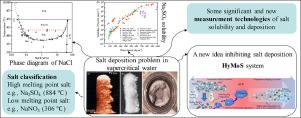Water Research ( IF 11.4 ) Pub Date : 2022-09-25 , DOI: 10.1016/j.watres.2022.119167 Peng Feng 1 , Wanpeng Yang 1 , Donghai Xu 1 , Mingyan Ma 1 , Yang Guo 1 , Zefeng Jing 1

|
The efficient and harmless treatment of hypersaline organic wastes has become an urgent environmental problem. Compared to traditional thermochemical methods, supercritical water oxidation has been proven to be an efficient organic waste treatment technology due to the advantages of low cost, high degradation rate, no secondary pollutants, etc. However, the solubilities of inorganic salts drop rapidly near the critical point of water, and some sticky salts form easily agglomerates and then adhere to internal surfaces of reactor and pipeline, causing plugging and inhibition of heat transfer. Hence, the characteristics, mechanisms and measurement methods of the dissolution and deposition of inorganic salts in sub-/supercritical water are summarized and analyzed systematically and comprehensively in this work, intending to provide a valuable guide for salt deposition prevention and subsequent research directions. Firstly, a new classification form of inorganic salt is put forward based on melting point. The phase equilibriums of brine systems are then analyzed in detail. Six theories concerning dissolution mechanisms are discussed deeply and various measurement methods of salt solubility are also supplemented. Furthermore, salt deposition characteristics and related measurement technologies are summarized. Notably, a new idea “hydrothermal molten salt” system is reviewed which may provide a solution for salt deposition in sub/supercritical water. Finally, an outlook for the follow-up researches is prospected and some suggestions are proposed.
中文翻译:

无机盐在亚/超临界水中溶解和沉积的特征、机理和测量方法
高盐有机废弃物的高效无害化处理已成为亟待解决的环境问题。与传统的热化学方法相比,超临界水氧化法具有成本低、降解率高、无二次污染物等优点,已被证明是一种高效的有机废物处理技术,但无机盐在临界值附近溶解度迅速下降。水点,一些粘性盐容易结块,附着在反应器和管道的内表面,造成堵塞,阻碍传热。因此,本文对无机盐在亚/超临界水中溶解和沉积的特征、机理和测量方法进行了系统、全面的总结和分析,旨在为盐沉积防治及后续研究方向提供有价值的指导。首先,提出了一种基于熔点的无机盐分类新形式。然后详细分析盐水系统的相平衡。深入探讨了有关溶解机理的六种理论,并补充了各种盐溶解度的测量方法。此外,总结了盐沉积特征和相关测量技术。值得注意的是,回顾了一种新的想法“热液熔盐”系统,该系统可能为亚/超临界水中的盐沉积提供解决方案。最后对后续研究进行了展望并提出了一些建议。提出了一种基于熔点的无机盐新分类形式。然后详细分析盐水系统的相平衡。深入探讨了有关溶解机理的六种理论,并补充了各种盐溶解度的测量方法。此外,总结了盐沉积特征和相关测量技术。值得注意的是,回顾了一种新的想法“热液熔盐”系统,该系统可能为亚/超临界水中的盐沉积提供解决方案。最后对后续研究进行了展望并提出了一些建议。提出了一种基于熔点的无机盐新分类形式。然后详细分析盐水系统的相平衡。深入探讨了有关溶解机理的六种理论,并补充了各种盐溶解度的测量方法。此外,总结了盐沉积特征和相关测量技术。值得注意的是,回顾了一种新的想法“热液熔盐”系统,该系统可能为亚/超临界水中的盐沉积提供解决方案。最后对后续研究进行了展望并提出了一些建议。深入探讨了有关溶解机理的六种理论,并补充了各种盐溶解度的测量方法。此外,总结了盐沉积特征和相关测量技术。值得注意的是,回顾了一种新的想法“热液熔盐”系统,该系统可能为亚/超临界水中的盐沉积提供解决方案。最后对后续研究进行了展望并提出了一些建议。深入探讨了有关溶解机理的六种理论,并补充了各种盐溶解度的测量方法。此外,总结了盐沉积特征和相关测量技术。值得注意的是,回顾了一种新的想法“热液熔盐”系统,该系统可能为亚/超临界水中的盐沉积提供解决方案。最后对后续研究进行了展望并提出了一些建议。











































 京公网安备 11010802027423号
京公网安备 11010802027423号